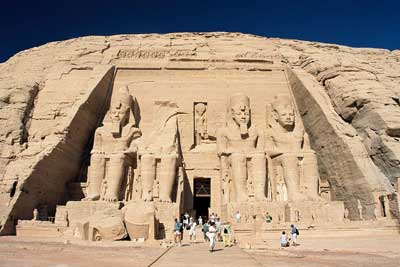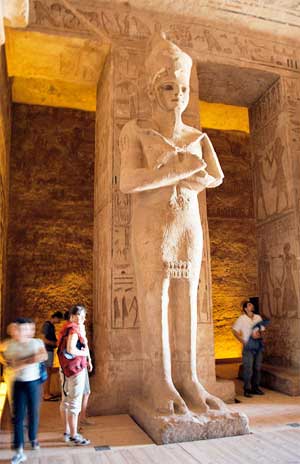Abu Simbel
 |
| Greater
Temple of Abu Simbel |
Abu Simbel Excursion:
PRIVATE GUIDED TOUR
By Air: $85 per person PLUS flights (based on a minimum of two travelers)
By road: $92 per person (based on a minimum of two travelers)
AIR: Staff will meet you at your hotel or cruise for transfer to the Aswan airport, assist with checking in and you fly to Abu Simbel with your guide. Flying time is about 45 minutes on an Egyptair jet. Arriving transfer by motor coach to the temples. The temple tour is about 2 hours in length which is plenty of time to see everything. Then take the motor coach back to the Abu Simbel airport to board your return flight to Aswan. Arriving Aswan staff transfers you to your hotel or cruise.
ROAD: Staff will meet you at your hotel or cruise for the drive to Aswan. This is about 3.5 hours in a convoy. (288 KM or about 178 miles each way). Arriving tour the temples for approximately two hours with your private guide then return to Aswan. Overall this is about a 9 - 10 hour excursion.
The Temple History:
Abu Simbel is an archaeological site
comprising two massive rock temples in southern Egypt on the
western bank of Lake Nasser about 290 km southwest of Aswan.
It is part of the UNESCO World Heritage Site known as the
"Nubian Monuments", which run from Abu Simbel downriver to
Philae (near Aswan).
The twin temples were originally
carved out of the mountainside during the reign of Pharaoh
Ramesses II in the 13th century BC, as a lasting monument
to himself and his queen Nefertari, to commemorate his alleged
victory at the Battle of Kadesh, and to intimidate his Nubian
neighbors. However, the complex was relocated in its entirety
in the 1960s, on an artificial hill made from a domed structure,
high above the Aswan dam reservoir.
The relocation of the temples was
necessary to avoid being submerged during the creation of
Lake Nasser, the massive artificial water reservoir formed
after the building of the Aswan dam on the Nile River. Abu
Simbel remains one of Egypt's top tourist attractions.
History
Construction
Construction of the temple complex started in approximately
1284 BC and lasted for circa 20 years, until 1264 BC. Known
as the "Temple of Ramesses, beloved by Amun", it was one of
six rock temples erected in Nubia during the long reign of
Ramesses. Their purpose was to impress Egypt's southern neighbours,
and also to reinforce the status of Egyptian religion in the
region.
Relocation
In 1959 an international donations campaign to save the monuments
of Nubia began: the southernmost relics of this ancient human
civilization were under threat from the rising waters of the
Nile that were about to result from the construction of the
Aswan High Dam.
The salvage of the Abu Simbel temples
began in 1964, and cost some USD $80 million. Between 1964
and 1968, the entire site was cut into large blocks, dismantled
and reassembled in a new location – 65 m higher and 200 m
back from the river, in what many consider one of the greatest
feats of archaeological engineering. Today, thousands of tourists
visit the temples daily. Guarded convoys of buses and cars
depart twice a day from Aswan, the nearest city. Many visitors
also arrive by plane, at an airfield that was specially constructed
for the temple complex.
Temples
The complex consists of two temples.
The larger one is dedicated to Ra-Harakhty, Ptah and Amun,
Egypt's three state deities of the time, and features four
large statues of Ramesses II in the facade. The smaller temple
is dedicated to the goddess Hathor, personified by Nefertari,
Ramesses's most beloved wife (in total, the pharaoh had some
200 wives and concubines).
The Greater
Temple
The greater Abu Simbel temple is generally considered the
grandest and most beautiful of the temples commissioned during
the reign of Ramesses II, and one of the most beautiful in
Egypt.
The facade is 33 meters high, and
38 meters broad, and guarded by four statues, each of which
is 20 meters high. They were sculptured directly from the
rock in which the temple was located before it was moved.
All statues represent Ramesses II, seated on a throne and
wearing the double crown of Upper and Lower Egypt. The statue
to the left of the entrance was damaged in an earthquake,
leaving only the lower part of the statue still intact. The
head and torso can still be seen at the statue's feet.
 |
| One of the eight pillars in the main hall of the temple, showing Ramesses II as Osiris. |
Several smaller figures are situated
at the feet of the four statues, depicting members of the
pharaoh's family. They include his mother Tuya, Nefertari,
and some of his sons and daughters.
Above the entrance there is a statue
of a falcon-headed Ra-Harakhte, with the pharaoh shown worshipping
on both sides of him. Below the statue there is an ancient
rebus, showing the prenomen or throne name of Ramesses: Waser-ma'at.
The facade is topped by a row of
22 baboons, their arms raised in the air, supposedly worshipping
the rising sun. Another notable feature of the facade is a
stele which records the marriage of Ramesses with a daughter
of king Hattusili III, which sealed the peace between Egypt
and the Hittites.
The inner part of the temple has
the same triangular layout that most ancient Egyptian temples
follow, with rooms decreasing in size from the entrance to
the sanctuary.
The first hall of the temple features
eight statues of the deified Rameses II in the shape of Osiris,
serving as pillars. The walls depict scenes of Egyptian victories
in Libya, Syria and Nubia, including images from the Battle
of Kadesh. The second hall depicts Ramesses and Nefertari
with the sacred boats of Amun and Ra-Horakthy.
The sanctuary contains four seated
statues of Ra-Horakhty, Ptah, Amun and Ramesses. The temple
was constructed in such a way that the sun shines directly
on all four statues during two days of the year, February
20 and October 20. These dates are allegedly the king's birthday
and coronation day respectively, but there is no evidence
to support this. Due to the displacement of the temple, it
is widely believed that this event now occurs one day later
than it did originally.
The Smaller Abu Simbel
Temple
The Smaller Abu Simbel Temple is located north of the Greater
Temple. It was carved in the rock by Ramesses II and dedicated
to Hathor, the goddess of love and beauty, and also to his
favorite wife, Nefertari, for "whose sake the very sun doeth
shine." The façade is adorned by six statues, four of Ramesses
II and two of Nefertari. Most unusually, the six are the same
height, which indicates the esteem in which Nefertari was
held. The entrance leads to a hall containing six pillars
bearing the head of the goddess Hathor.
The eastern wall bears inscriptions
depicting Ramesses II striking the enemy before Ra-Harakhte
and Amun-Ra. Other wall scenes show Rameses II and Nefertari
offering sacrifices to the gods. Beyond this hall, there is
another wall with similar scenes and paintings. In the farthest
depths of the temple is the holy of holies, where a statue
of the goddess Hathor stands.
This is, indeed, a most awesome sight
to the visitor; for here he finds the greatest artificial
dome that bears the man-made mountain behind the Temples of
Abu Simbel. It shows the great work of Ramesses II.